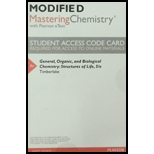
Concept explainers
(a)
Interpretation:
K-40 has a
To write a balanced
Concept Introduction:
According to the law of conservation of mass the sum of the
(b)
Interpretation:
K-40 has a natural abundance of 0.012% and a half-life of 1.30 x 109yr. K-40 decays to Ca-40 or to Ar-40. Activity for K-40 is 7.0 µCi per gm.
To identify the particle emitted for each type of decay.
Concept Introduction:
Radioactive decay is the process by which an unstable atomic nucleus loses energy by emitting radiation, such as an alpha particle, beta particle with neutrino.
(c)
Interpretation:
K-40 has a natural abundance of 0.012% and a half-life of 1.30 x 109yr. K-40 decays to Ca-40 or to Ar-40. Activity for K-40 is 7.0 µCi per gm.
To find the number of K+ ions in 3.5 oz of KCl
Concept Introduction:From the mass and molar mass of a substance, number of moles can be calculated as follows:
(d)
Interpretation:
K-40 has a natural abundance of 0.012% and a half-life of 1.30 x 109yr. K-40 decays to Ca-40 or to Ar-40. Activity for K-40 is 7.0 µCi per gm.
To find the activity of 25g of KCl in becquerels
Concept Introduction:
An arithmetical multiplier which is used for converting a quantity expressed in one unit into another equivalent set of units is said to be conversion factor.
The conversion factor used to convert curie to becquerel is as follows:
Want to see the full answer?
Check out a sample textbook solution
Chapter 16 Solutions
Modified MasteringChemistry with Pearson eText - Valuepack Access Card - for General, Organic, and Biological Chemistry: Structures of Life
 ChemistryChemistryISBN:9781305957404Author:Steven S. Zumdahl, Susan A. Zumdahl, Donald J. DeCostePublisher:Cengage Learning
ChemistryChemistryISBN:9781305957404Author:Steven S. Zumdahl, Susan A. Zumdahl, Donald J. DeCostePublisher:Cengage Learning ChemistryChemistryISBN:9781259911156Author:Raymond Chang Dr., Jason Overby ProfessorPublisher:McGraw-Hill Education
ChemistryChemistryISBN:9781259911156Author:Raymond Chang Dr., Jason Overby ProfessorPublisher:McGraw-Hill Education Principles of Instrumental AnalysisChemistryISBN:9781305577213Author:Douglas A. Skoog, F. James Holler, Stanley R. CrouchPublisher:Cengage Learning
Principles of Instrumental AnalysisChemistryISBN:9781305577213Author:Douglas A. Skoog, F. James Holler, Stanley R. CrouchPublisher:Cengage Learning Organic ChemistryChemistryISBN:9780078021558Author:Janice Gorzynski Smith Dr.Publisher:McGraw-Hill Education
Organic ChemistryChemistryISBN:9780078021558Author:Janice Gorzynski Smith Dr.Publisher:McGraw-Hill Education Chemistry: Principles and ReactionsChemistryISBN:9781305079373Author:William L. Masterton, Cecile N. HurleyPublisher:Cengage Learning
Chemistry: Principles and ReactionsChemistryISBN:9781305079373Author:William L. Masterton, Cecile N. HurleyPublisher:Cengage Learning Elementary Principles of Chemical Processes, Bind...ChemistryISBN:9781118431221Author:Richard M. Felder, Ronald W. Rousseau, Lisa G. BullardPublisher:WILEY
Elementary Principles of Chemical Processes, Bind...ChemistryISBN:9781118431221Author:Richard M. Felder, Ronald W. Rousseau, Lisa G. BullardPublisher:WILEY





